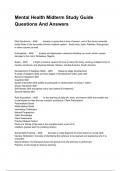Mental Health Midterm Study Guide
Questions And Answers
Dhat Syndrome: - ANS anxiety or upset due to loss of semen, one of the seven essential
bodily fluids in the Ayurvedic (Hindu) medical system - South Asia, India, Pakistan. Recognized
in other cultures as well.
Kufungisisa: - ANS anxiety and depression caused by thinking too much, which causes
damage to the mind. Zimbabwe, Nigeria.
Susto: - ANS a fright or trauma causes the soul to leave the body, causing multiple forms of
mental, emotional, and physical distress. Mexico, Central America, South America
Development of Adaptive Skills: - ANS Stage-by-stage development.
6 areas of adaptive skills and lists stages of development within each skill.
Sensory Integration Skill
Cognitive Skill
Dyadic Interaction Skill (ability to participate in relationships involving 1 other).
Group Interaction Skill
Self-Identity Skill (recognize one's own assets & limitations).
Sextual Identity Skill.
Role Acquisition: - ANS Is the learning of daily life, work, and leisure skills that enable one
to participate in roles that are social/or productive. Client Participation
Personalized Goals
Ability Based Goals
Increasing Challenges
Natural Progression
Client Knowledge
Client Awareness
Practice Makes Perfect
Parts of a Whole (if the task is too complex teach a part of it).
Imitation (people learn by imitating others).
Social Skills Training: - ANS Success in roles depends to some extent on social skills
training. Motivation: Consists of identifying the behavior to be learned and explaining why it is
important.
Demonstration: the therapist shows the person how the behavior is performed.
Practice: Is structured to improve learning.
,Feedback: is given at the end of the treatment session and summarizes what the person has
learned.
Psychoeducation: - ANS Is not technically an OT model but an educational approach used
for people with mental disorders. It is in a classroom environment. Syllabus, semi structured
interview, task checklist, Kohlman Evaluation of Living Skills, and Pretest & Post test are
generally given.
Sensory Integration (SI): - ANS A, Jean Ayres, Lorna Jean King. Is the smooth working
together of all of the senses to provide information needed for accurate perception and motor
action. Includes the 5 senses (sight, hearing, taste, smell, and touch). Also,
Proprioception: the sense that helps us identify where parts of our bodies are even if we cannot
see them.
Vestibular awareness: the sense that detects motion and the pill of gravity during movement.
First, attention should be focused on the outcome of the activity or on the objects used in it
rather than on the movements. Second, the activity should be pleasurable.
Sensory Processing: - ANS Aims to make the person more conscious of how sensation
affects activity behavior. Refers to the coordinated activities of multiple sensory receptors and
neurological centers that are responsible for: Receiving & conducting, registering, recognizing,
discriminating, and modulating.
Sensory Modulation: the regulation (control or moderation) of sensation itself or of behavioral
responses to sensory stimulation.
Cognitive Disabilities: - ANS Claudia Kay Allen. Focuses on the effect of impaired
cognition. Central concept is that some people with psychiatric and neurological disorders suffer
from a disturbance in the mental functions that guide motor actions.
ACLs-5 leather-lacing.
Model of Human Occupation (MOHO): - ANS Gary Kielhofner. Includes Volition,
habituation, performance capacity and environment.
Person Environment Occupation (PEO): - ANS Mary Law. Person-centered model that
focuses on the occupational performance that results from transactions between the person and
the environment as the person engages in occupation.
Intellectual Disability: - ANS Intellectual functioning that is below average, deficits in
adaptive functioning (daily life activities and roles), onset before age 18. Deficits in self care,
impaired social functioning, impaired/absent vocational functioning, perceptual-motor deficits.
Behavior management can be challenging.
Communication Disorder: - ANS When impairment of speech or language is significant
enough to interfere with academic or daily functioning. OTA may only work with these children if
nonverbal.
, Autism Spectrum Disorder (ASD): - ANS Impaired sensory processing and sensory
integration. Perceptual-motor deficits such as in posture or coordination. Deficits in social
interaction. Self-care deficits. Independent living skills such as community mobility. School
behavior skills such as attention and following rules and routines. Emotion regulation.
Occupational functioning.
Attention Deficit Hyperactivity Disorder (ADHD): - ANS Approximately 5% of school aged
children and 2.5% of adults. Twice as prevalent in males than in females. Inattention.
Hyperactivity and Impulsivity. A combination of these. Behavior must be sustained for 6 months
to diagnose. Scaffolding & structure to compensate for deficient internal controls. Signage and
reminders. Use of portable electronic devices to cue behavior. Parent and teacher education
about the need for scheduled breaks and gross motor activities. Sensory integration activities
and sensory processing education. Modifications to home or classroom or workplace.
Specific Learning Disabilities: - ANS That negatively affects the learning process. Could be
related to language, reading, visual spatial organization, mathematics, and writing. Can also
have a combination.
Oppositional Defiant Disorder (ODD): - ANS Can be diagnosed in childhood. Hard to
handle, argumentative & resentful behavior, irritability, and refusal to follow rules or instruction.
Intermittent Explosive Disorder: - ANS Prone to frequent tantrums and may destroy
property or become aggressive toward people or pets.
Conduct Disorder: - ANS Pattern of violating others rights. May include aggression,
destruction of property, theft, deceitfulness, and other deviant and antisocial behavior.
Sensory processing. Executive functions and impulse control. Skill development and
compensatory measures for academic, social, and occupational roles. Emotional identification
and regulation. Social skills training.
Schizophrenia: - ANS Characterized by specific psychotic symptoms , deterioration of
functioning from a previously higher level, and duration of illness of at least 6 months. 3 phases:
prodromal (beginning), active, and residual (remission).
Hallucinations: - ANS Experiences of sensation that occur without any external stimulus
being present (voices, see people or objects, feel things crawling on skin). Auditory is most
common, then visual.
Delusions: - ANS fixed beliefs that are not amenable to change in light of conflicting
evidence. Types include: Ideas of Reference, Thought withdrawal, thought insertion, grandiose,
paranoia.




